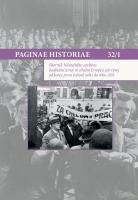Podkarpatská Rus na jednáních II. a III. sjezdu KSČ v polovině dvacátých let 20. století
Carpathian Ruthenia at the Meetings of the Second and Third Congress of the Communist Party of Czechoslovakia in the mid-1920s
Author(s): David HubenýSubject(s): History, History of ideas, Recent History (1900 till today), Interwar Period (1920 - 1939), History of Communism
Published by: Národní archiv
Keywords: Carpathian Rus; communism; political parties; Czechoslovakia 1918-1938
Summary/Abstract: The elections and congresses in the mid-1920s drew the attention of the rest of the communist party to the influence of the Carpathian Ruthenia comrades on the local population. At the same time, the congresses noted that despite the influence and ability to organise highly attended events and evoke strong participation by the population, the local communists lacked the organisational framework and, most importantly, leading party cadres. The Carpathian Ruthenia representatives were also well aware of this situation, complaining about the poor interest of the centre as well as the weak responses of the comrades from the historical lands to the blood shedding in Carpathian Ruthenia. The headquarters received only sporadic reports about the Carpathian Ruthenia development, and if they did get any information, they could not use it because a poor translation made it incomprehensible. On the other hand, several Carpathian Ruthenia communists emerged as early as the mid-1920s who became widely famous within the party and were appointed to higher party posts. The mid-1920s congresses enabled the rest of the party to learn some facts about Carpathian Ruthenia, yet the more prestigious communist press published only a short summary as late as the summer of 1926. Naturally, Rudé právo (Red Justice), for example, publicised the speeches of the party representatives on Carpathian Ruthenia at the National Assembly beginning in 1921. Concurrently, indications emerged that the Carpathian Ruthenia communist representatives did not see the future of this territory in Czechoslovakia but rather within the Soviet Union, although the republic did not have a border with the latter until the end of the Second World War. Similarly, it was evident that contacts would deepen with Ukrainian communists from the Soviet Union that was to further influence the national development.
Journal: Paginae Historiae
- Issue Year: 32/2024
- Issue No: 1
- Page Range: 359-379
- Page Count: 21
- Language: Czech

